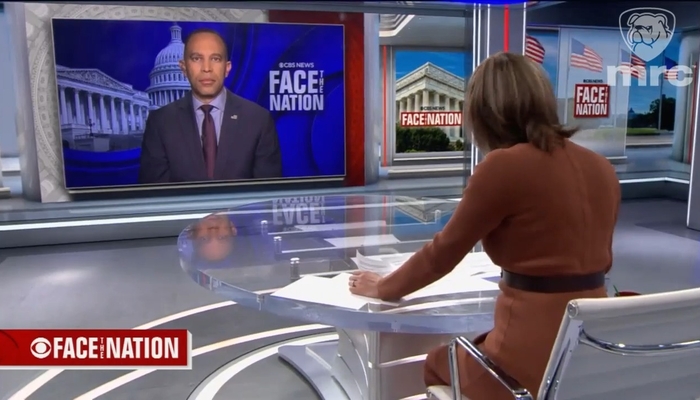
www.newsbusters.org
MSNBC's Soboroff Repeats Misinfo from the 'Kids in Cages' Smear
On Thursday's The Last Word show, MSNBC senior national correspondent and anti-ICE propagandist Jacob Soboroff repeated several pieces of misinformation over the 2018 separation of illegal immigrant families as he complained about the Trump administration recently deporting some of the families who used to be separated.
Filling in for regular host Lawrence O'Donnell, Soboroff misleadingly recalled that during the first Trump administration, migrant children were put in cages, and used a discredited photograph of a child crying as if she had been separated from her parents even though she was not.
He even played a clip of himself from 2018 predicting that Trump would cause more babies to die in the desert even though it was during the Biden administration that record numbers of migrants died in the desert while Trump's deterrence policy has caused deaths to plummet since January.
After beginning the segment by complaining that President Donald Trump is still trying to get court approval to hold "migrants" as detainees at Guantanamo Bay, Soboroff segued by reaching back to the past: "It comes as the ACLU is standing up to Donald Trump once again over the victims of Trump's cruelest first-term policy -- taking children and babies from their parents and detaining them in cages."
He then played a clip of himself from June 19, 2018, speaking with O'Donnell about what he had seen on the border. Soboroff had related:
Inside this building that we're standing in front of, 1100 kids have been separated from their parents that was inside the building, and there are babies sitting by themselves in a cage with other babies. ... Where are they going to put those babies when their parents are picked up and sent into a federal prison or a local jail and then deported, and then they never come back?
He then predicted:
You want to know what happens next? The babies don't end up making it into a facility like this: The parents that normally would come with those babies don't show up to declare asylum -- they decide to run from the border patrol instead. And the next chapter in this story is we're going to be seeing pictures of dead babies in the Arizona desert and in the south Texas brush.
That's what happens when you put deterrence in place, and that's what's going to happen next in this story. You're going to have babies dying coming into the United States because families are afraid to seek asylum because they don't want those babies to end up in tender age shelters.
But it was during the Biden administration that there were record numbers of bodies being recovered on the border when President Joe Biden was trying to make it easier for asylum seekers to enter.
It was also not noted that it was the Barack Obama administration that constructed cage-like structures, as explained later by Obama's Homeland Security Secretary Jeh Johnson, because it was the safest way they could detain tremendous numbers of migrants so that border agents could see that women and children were not being abused by other detainees.
And, needless to say, Soboroff did not remind viewers that it was those who brought their children across the border illegally who were separated from their children, complying with federal law demanding that all illegal aliens be detained while it was deemed by court ruling to be illegal to hold children in the same facilities with their parents.
He then showed excerpts of an online article from LAist which displayed an infamous image of a child crying on the border in 2018 which was used at the time as alleged evidence of children being made to suffer from family separation even though it turned out she was not separated from her parents. But that hasn't kept some in the liberal media from misleadingly exploiting the image anyway.
Soboroff went on to speak with the ACLU's Lee Gelernt about his efforts to stop the Trump administration from deporting families who had been reunited and allowed to remain during the Biden administration.
Transcript of relevant portion follows:
MSNBC's The Last Word
October 23, 2025
JACOB SOBOROFF, FILL-IN HOST: It comes as the ACLU is standing up to Donald Trump once again over the victims of Trump's cruelest first-term policy -- taking children and babies from their parents and detaining them in cages.
LAWRENCE O'DONNELL, MSNBC HOST (from the June 19, 2018, The Last Word): Jacob, you've been reporting on the border for years now. I want to know if you've picked up any clues that were sounding like there's something out there called a "tender age shelter"?
SOBOROFF: I mean, Chris (Hayes) just hit the nail on the head, Lawrence. Inside this building that we're standing in front of, 1100 kids have been separated from their parents that was inside the building, and there are babies sitting by themselves in a cage with other babies. Where are those babies going to go? Where are they going to put those babies when their parents are picked up and sent into a federal prison or a local jail and then deported, and then they never come back? You want to know what happens next? The babies don't end up making it into a facility like this: The parents that normally would come with those babies don't show up to declare asylum -- they decide to run from the border patrol instead.
And the next chapter in this story is we're going to be seeing pictures of dead babies in the Arizona desert and in the south Texas brush. That's what happens when you put deterrence in place, and that's what's going to happen next in this story. You're going to have babies dying coming into the United States because families are afraid to seek asylum because they don't want those babies to end up in tender age shelters.
SOBOROFF (live): That was in 2018, and this is a case that is still going on today. LAist has this report on what happened next:
Seven years ago, the first Trump administration triggered a global condemnation when news broke that it was forcibly separating children from their families at the U.S.-Mexico Border. The outcry led the administration to shutter the program, but thousands of families remained shattered. A class-action lawsuit followed, and the Biden administration later settled the case. In the settlement agreement, the federal government promised to repair some of the damage by reuniting the families in the U.S. and providing them with a path to asylum.
Now, the second Trump administration is quietly abandoning that promise, putting thousands of once-separated families at risk of being split up a second time. At least four families have been deported already. That's according to the American Civil Liberties Union, which brought the original lawsuit known as Ms. L. v. ICE, on behalf of separated families. The ACLU filed a motion in federal court on Tuesday asking for the recently deported families to be returned to the U.S., alleging that at least one of the deportations violated an explicit court order.
That lawsuit details some of the horrific stories that these families have been through.















